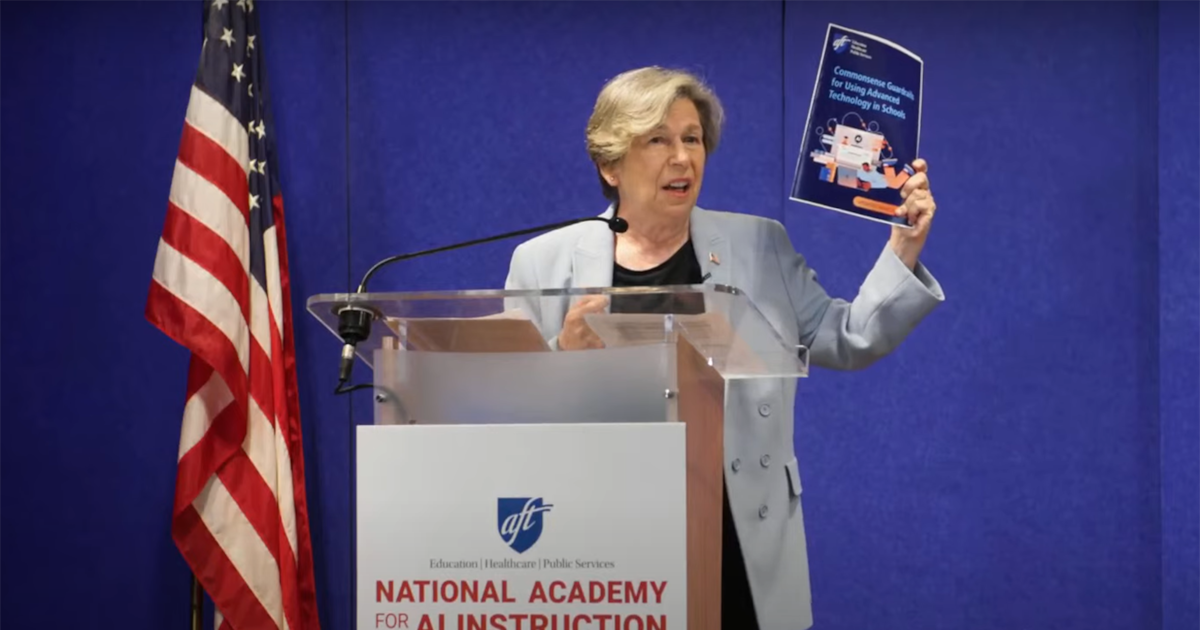Tools & Platforms
Expanded AI training for teachers, funded by OpenAI and Microsoft

Sign up for Chalkbeat’s free weekly newsletter to keep up with how education is changing across the U.S.
More than 400,000 K-12 educators across the country will get free training in AI through a $23 million partnership between a major teachers union and leading tech companies that is designed to close gaps in the use of technology and provide a national model for AI-integrated curriculum.
The new National Academy for AI Instruction will be based in the downtown Manhattan headquarters of the United Federation of Teachers, the New York City affiliate of the American Federation of Teachers, and provide workshops, online courses, and hands-on training sessions. This hub-based model of teacher training was inspired by work of unions like the United Brotherhood of Carpenters that have created similar training centers with industry partners, according to AFT President Randi Weingarten.
“Teachers are facing huge challenges, which include navigating AI wisely, ethically and safely,” Weingarten said at a press conference Tuesday announcing the initiative. “The question was whether we would be chasing it or whether we would be trying to harness it.”
The initiative involves the AFT, UFT, OpenAI, Microsoft, and Anthropic.
The Trump administration has encouraged AI integration in the classroom. More than 50 companies have signed onto a White House pledge to provide grants, education materials, and technology to invest in AI education.
In the wake of federal funding cuts to public education and the impact of Trump’s sweeping tax and policy bill on schools, Weingarten sees this partnership with private tech companies as a crucial investment in teacher preparation.
“We are actually ensuring that kids have, that teachers have, what they need to deal with the economy of today and tomorrow,” Weingarten said.
The academy will be based in a city where the school system initially banned the use of AI in the classroom, claiming it would interfere with the development of critical thinking skills. A few months later, then-New York City schools Chancellor David Banks did an about-face, pledging to help schools smartly incorporate the technology. He said New York City schools would embrace the potential of AI to drive individualized learning. But concrete plans have been limited.
The AFT, meanwhile, has tried to position itself as a leader in the field. Last year, the union released its own guidelines for AI use in the classroom and funded pilot programs around the country.
Vincent Plato, New York City Public Schools K-8 educator and UFT Teacher Center director, said the advent of AI reminds him of when teachers first started using word processors.
“We are watching educators transform the way people use technology for work in real time, but with AI it’s on another unbelievable level because it’s just so much more powerful,” he said in a press release announcing the new partnership. “It can be a thought partner when they’re working by themselves, whether that’s late-night lesson planning, looking at student data or filing any types of reports — a tool that’s going to be transformative for teachers and students alike.”
Teachers who frequently use AI tools report saving 5.9 hours a week, according to a national survey conducted by the Walton Family Foundation in cooperation with Gallup. These tools are most likely to be used to support instructional planning, such as creating worksheets or modifying material to meet students’ needs. Half of the teachers surveyed stated that they believe AI will reduce teacher workloads.
“Teachers are not only gaining back valuable time, they are also reporting that AI is helping to strengthen the quality of their work,” Stephanie Marken, senior partner for U.S. research at Gallup, said in a press release. “However, a clear gap in AI adoption remains. Schools need to provide the tools, training, and support to make effective AI use possible for every teacher.”
While nearly half of school districts surveyed by the research corporation RAND have reported training teachers in utilizing AI-powered tools by fall 2024, high-poverty districts are still lagging behind their low poverty counterparts. District leaders across the nation report a scarcity of external experts and resources to provide quality AI training to teachers.
OpenAI, a founding partner of the National Academy for AI Instruction, will contribute $10 million over the next five years. The tech company will provide educators and course developers with technical support to integrate AI into classrooms as well as software applications to build custom, classroom-specific tools.
Tech companies would benefit from this partnership by “co-creating” and improving their products based on feedback and insights from educators, said Gerry Petrella, Microsoft general manager, U.S. public policy, who hopes the initiative will align the needs of educators with the work of developers.
In a sense, the teachers are training AI products just as much as they are being trained, according to Kathleen Day, a lecturer at Johns Hopkins Carey Business School. Day emphasized that through this partnership, AI companies would gain access to constant input from educators so they could continually strengthen their models and products.
“Who’s training who?” Day said. “They’re basically saying, we’ll show you how this technology works, and you tell us how you would use it. When you tell us how you would use it, that is a wealth of information.”
Many educators and policymakers are also concerned that introducing AI into the classroom could endanger student data and privacy. Racial bias in grading could also be reinforced by AI programs, according to research by The Learning Agency.
Additionally, Trevor Griffey, a lecturer in labor studies at the University of California Los Angeles, warned the New York Times that tech firms could use these deals to market AI tools to students and expand their customer base.
This initiative to expand AI access and training for educators was likened to New Deal efforts in the 1930s to expand equal access to electricity by Chris Lehane, OpenAI’s chief global affairs officer. By working with teachers and expanding AI training, Lehane hopes the initiative will “democratize” access to AI.
“There’s no better place to do that work than in the classroom,” he said at the Tuesday press conference.
Chalkbeat New York bureau chief Amy Zimmer contributed to this report.
Norah Rami is a Dow Jones education reporting intern on Chalkbeat’s national desk. Reach Norah at nrami@chalkbeat.org.
Tools & Platforms
When Good Intentions Kill Cures: A Warning on AI Regulation – The Fulcrum
Tools & Platforms
Larry Ellison Tops Billionaire List In AI Race: 8 Fun Facts

Larry Ellison, CEO of Oracle Corporation (TORU YAMANAKA/AFP via Getty Images)
AFP via Getty Images
With data center spending hitting record highs amid the AI boom, it’s no wonder Larry Ellison, cofounder, chair and chief technology officer of cloud giant Oracle, is now rivaling Elon Musk for the title of World’s Richest Man.
The company reported a 359% jump in order backlog during its first quarter 2026 earnings call, sending its stock soaring 36% for the day. This landed Ellison, who owns more than 40% of shares, at the top of the Forbes Billionaires List, second only to his good friend, Elon Musk.
For perspective, the net worth of the seven wealthiest people in the world–all AI luminaries including Meta’s Mark Zuckerberg, Amazon’s Jeff Bezos, Google’s Larry Page and Sergey Brin and Nvidia’s Jensen Huang–exceeds $2 trillion, close to the GDP of Canada.
Ellison, now 81, has been a billionaire since he was 47, but there are a number of surprising things about him that make his rags to riches story iconically American.
1. Born into poverty
Ellison’s birth mom was an unwed teenager in New York City during World War II who had to give him up for adoption. His maternal aunt and uncle raised him in a poor neighborhood on the south side of Chicago.
His father, a hard-working Russian immigrant and patriotic US bomber pilot, taught him to respect authority. But as the 1960s took hold, he dropped out of college to forge his own path and follow his passion for computer programming.
2. From CIA to Billionaire
He moved to Berkeley to code for a number of tech companies, and landed a job at Ampex where he was put on a team to build a database called “Oracle” for the CIA.
Inspired by the IBM research paper titled, “A Relational Model of Data for Large Shared Data Banks,” he and his colleagues left to form a startup to beat IBM to market in commercializing relational databases. They bootstrapped the company with $2,000 of their own money and landed a $50,000 contract from the CIA that seeded their startup. A few years later they renamed the company Oracle with backing by Sequoia Capital. They went public in 1986, a day before Microsoft, and in 1990 Ellison became a billionaire.
3. Fun with Steve Jobs
Both as Silicon Valley tech titans and Woodside neighbors, Ellison and Steve Jobs were good friends. Ellison has spoken extensively about their close relationship, recalling how Jobs made him watch 73 different versions of Toy Story, the first full length feature of Pixar, the animation studio which Jobs bought from George Lucas for $10 million after being fired from Apple, and later sold to Disney for $7.4 billion in an all-stock transaction becoming the Mickey Mouse’s largest shareholder.
Ellison even offered to buy Apple to help Jobs return after his ousting, but Job declined and decided to persuade the board to take him back after he sold them his NeXT operating system. In 1997, Jobs was reinstated as CEO and Ellison joined Apple’s board.
4. Betting on AI
Following Jobs death from pancreatic cancer in 2011, Ellison doubled down on research establishing the Ellison Institute of Technology at USC with a $200 million gift in 2016 for cancer treatment. More recently, he led the Series B round for Imagene AI which calls itself the OpenAI for precision oncology.
Although his main AI investment has always been Oracle, doubling his ownership over time, Ellison has made other notable tech bets. In 1999, he seeded Salesforce and in 2018 invested in Tesla and took a board seat, later backing Musk to buy Twitter. He was also an early investor in the now-defunct home testing startup Theranos.
5. Buying Hawaii
In 2012, Ellison bought 98% of the island of Lanai from David Murdock, the CEO of Dole Food Company and owner of real estate holding company, Castle & Cooke. According to Bloomberg, he paid $300 million for the land which included Four Seasons Lanai, where he and Jobs had frequently vacationed together.
The resort now operates Ellison’s Sensei wellness retreat where AI is used to provide personalized plans, deliver insights, and customize treatments like thermal body mapping massage.
6. Buying Hollywood
In recent years, Ellison has been on a tear acquiring Hollywood studios. He just bought Paramount Global for $8.4 billion as co-owner of his son’s Skydance Media, and has been reported to be preparing a bid for Warner Brothers Discovery, which now has a market cap of $40 billion.
Ellison’s son David is best known for producing movies in the Top Gun, Mission Impossible and Star Trek franchises, including Top Gun: Maverick one of the highest grossing films of all time, with a box office gross of $1.5 billion. His daughter Megan is also an accomplished filmmaker with Annapurna Pictures which produced the Oscar-winning AI movie, Her, along with other arthouse films including Phantom Thread, American Hustle and Vice.
Ellison and Musk had billionaire cameos in Iron Man 2.
7. Pledges to give it all away
A good friend of philanthropist Michael Milken who has raised billions of dollars for cancer research, Ellison believes the road to bliss is altruistic giving. In 2010, he signed the Giving Pledge, a campaign started by Bill and Melinda Gates and Warren Buffet to encourage billionaires to donate at least half their fortune during their lifetime. Ellison pledged to give away 95% of his wealth to advance scientific research and solve complex problems related to health and aging.
Other billionaires who signed the pledge include Mark Zuckerberg, Priscilla Chan, Mackenzie Scott, Michael Bloomberg, George Lucas and Ted Turner.
8. Immortality
Ellison looks as good now as he did decades ago when he first became a billionaire. A tea-totaler pescatarian who works out daily, doesn’t drink alcohol or do drugs, and prioritizes sleep. He’s kept his mind sharp by leaning into his interests: sailing, tennis, flying, Japanese culture, tournament chess, guitar, and by being in a relationship, even if it’s taken a half dozen marriages to accomplish this.
He says high achievers are driven more by fear of failure than the pursuit of success. When he was little, his greatest fear was losing his adopted mom, and he prayed and made all sorts of deals to make sure she’d return to him safely after she was late coming home from work one night. When he lost her in college to a long battle with cancer, he fell into a deep depression and dropped out. He later found that the intelligent pursuit of happiness lies in giving with intention and has been donating his fortune to solve for longevity ever since.
Hopefully with AI he’ll succeed and that will become his greatest legacy.
Tools & Platforms
Analysis-Malaysia reins in data centre growth, complicating China’s AI chip access

By Eduardo Baptista, Ashley Tang and Jun Yuan Yong
BEIJING/KUALA LUMPUR/SINGAPORE (Reuters) -Malaysia, a hotspot for data centres, is reining in the pace of expansion in a move industry insiders and analysts expect will hinder China’s efforts to gain access to powerful chips that are crucial to improving its artificial intelligence capabilities.
The Southeast Asian country has drawn in data centre investments from U.S. technology giants like Microsoft, Amazon, Alphabet’s Google and their Chinese counterparts Tencent, Huawei and Alibaba in recent years, spurred by cheap land and electricity costs and robust local AI demand prospects.
More than two-thirds of data centre capacity under construction in Southeast Asia’s five main growth markets has been committed in Malaysia, according to data centre consultancy DC Byte. Spillover from more expensive Singapore has driven companies to commit to more data centres in the neighbouring Malaysian state of Johor.
But the data centre boom has begun to slow as Malaysia grapples with power grid capacity and water resource constraints and pressure from Washington to not allow Chinese firms to use the region as a backdoor to access U.S.-made AI chips that are under export controls.
Malaysia, China’s largest trading partner in Southeast Asia, announced in July it was requiring permits for all exports, trans-shipments and transits of U.S.-made high-performance chips, such as those made by Nvidia.
Chinese-made replacements for the U.S. chips are still subpar alternatives for the sustainment and development of cutting-edge Chinese AI models and applications that can compete with their U.S. rivals.
The new restrictions leave regulatory wriggle room for Chinese data centres to import U.S. chips for in-country use.
However, scrutiny on these projects is bound to increase, experts say, as Malaysia tries to finalise a trade deal with the United States.
The U.S. Commerce Department has raised concerns that data centres outside China could purchase AI chips to train AI models in China, including to support military uses, said Collmann Griffin, a lawyer at Miller & Chevalier who previously served as a U.S. government sanctions policy adviser.
The U.S. Commerce Department did not respond to a request for comment.
‘AI BELT AND ROAD’
The overseas push by China began soon after it released a three-year action plan for Chinese data centre operators in 2021, calling on the firms to expand abroad, especially in countries signed onto Xi Jinping’s flagship overseas development Belt and Road Initiative, of which Malaysia is a signatory.
At the end of Xi’s visit to Malaysia in April, the countries released a joint statement that pledged growing cooperation on “data linkages”, 5G infrastructure and AI, pointing to the growing political momentum underlying China’s data centre capacity expansion in Malaysia.
GDS Holdings, one of China’s largest data centre operators, two years ago began operating a hyperscale data centre campus in Johor, a massive project that is still being expanded.
But as the U.S. continues to target China’s AI capabilities, GDS has gradually reduced its stake in the Singapore-headquartered subsidiary that managed its overseas data centres and spun it off into an independent entity called DayOne in January.
Lee Ting Han, Johor state’s data centre development coordination vice chair, said Chinese firms’ “rebranding” is likely to be aimed at diversifying their client base “because they know very well what’s happening, the trade tension is moving.”
At the groundbreaking of DayOne’s first data centre in Singapore in July, CEO Jamie Khoo said that the company always intended to split its business from its Chinese parent as both companies operate under different regulatory regimes.
Singapore had a three-year moratorium of new data centre builds until January 2022 due to power and water constraints, before announcing last year that it would unlock just 300 megawatts (MW) of data centre capacity “in the near term”.
As of December 2024, Johor had 12 operational data centres with a combined estimated capacity of 369.9 MW and an additional 28 were planned for future development, representing an estimated capacity of 898.7 MW, according to a Knight Frank report.
Johor has emerged as Malaysia’s leading data centre investment hub with 42 projects worth 164.45 billion ringgit ($39.08 billion) approved as of the second quarter of 2025 contributing 78.6% of the country’s operational IT capacity, the state’s chief minister said last month.
Its proximity to Singapore means Johor benefits from lower-latency connections to the city-state’s other data centres.
But Johor has begun to step on the brakes, introducing a vetting committee last year for data centre projects that rejected about 30% of applications as of late 2024 for failing to demonstrate sustainable practices for water and energy usage, Lee said.
The approval rate has gone up as applicants become more familiar with the process, he added.
Vivian Wong, a senior analyst at DC Byte, said Southeast Asian countries like Malaysia were attractive markets for Chinese data centre expansions due to geographic proximity, relatively lower political friction and growing digital infrastructure demand.
“However, as Southeast Asia faces increased scrutiny and tariffs, this may potentially reap lesser success when compared to earlier years, especially in markets known to host Chinese-backed operations that are also targeted by the Trump administration,” she said.
($1 = 4.2080 ringgit)
(Reporting by Eduardo Baptista in Beijing, Ashley Tang and Danial Azhar in Kuala Lumpur, Jun Yuan Yong in Singapore; Editing by Miyoung Kim and Jamie Freed)
-

 Business2 weeks ago
Business2 weeks agoThe Guardian view on Trump and the Fed: independence is no substitute for accountability | Editorial
-
Tools & Platforms1 month ago
Building Trust in Military AI Starts with Opening the Black Box – War on the Rocks
-

 Ethics & Policy2 months ago
Ethics & Policy2 months agoSDAIA Supports Saudi Arabia’s Leadership in Shaping Global AI Ethics, Policy, and Research – وكالة الأنباء السعودية
-

 Events & Conferences4 months ago
Events & Conferences4 months agoJourney to 1000 models: Scaling Instagram’s recommendation system
-

 Jobs & Careers2 months ago
Jobs & Careers2 months agoMumbai-based Perplexity Alternative Has 60k+ Users Without Funding
-

 Podcasts & Talks2 months ago
Podcasts & Talks2 months agoHappy 4th of July! 🎆 Made with Veo 3 in Gemini
-

 Education2 months ago
Education2 months agoMacron says UK and France have duty to tackle illegal migration ‘with humanity, solidarity and firmness’ – UK politics live | Politics
-

 Education2 months ago
Education2 months agoVEX Robotics launches AI-powered classroom robotics system
-

 Funding & Business2 months ago
Funding & Business2 months agoKayak and Expedia race to build AI travel agents that turn social posts into itineraries
-

 Podcasts & Talks2 months ago
Podcasts & Talks2 months agoOpenAI 🤝 @teamganassi






















